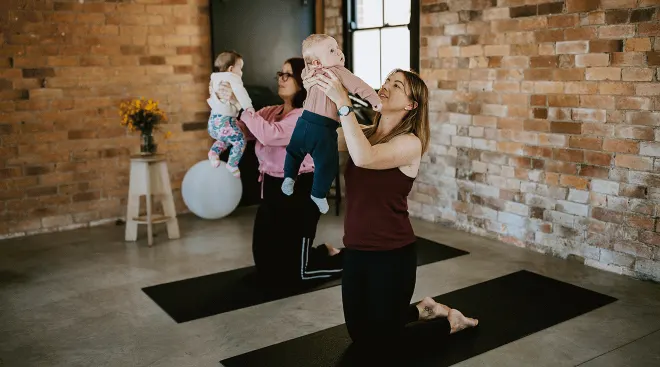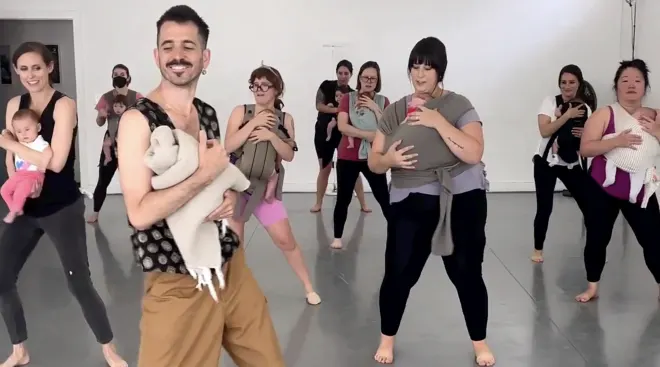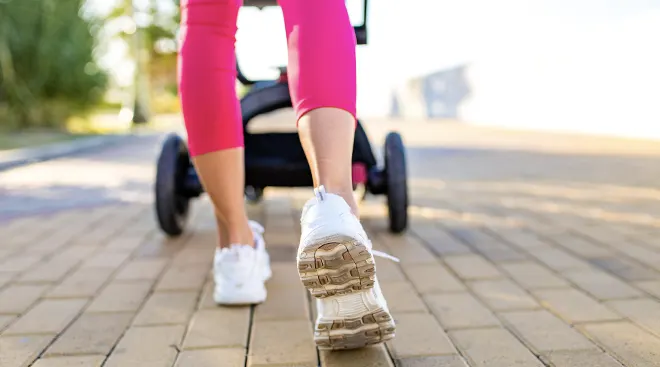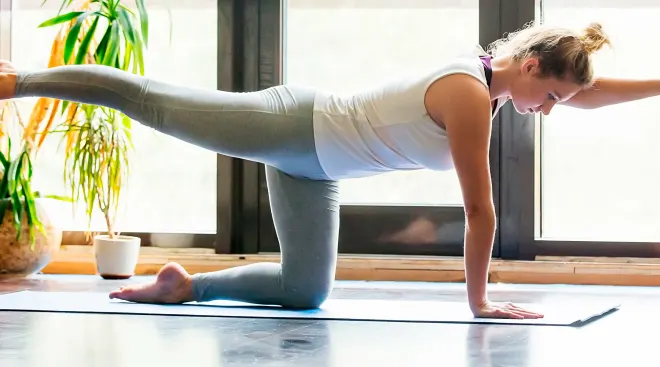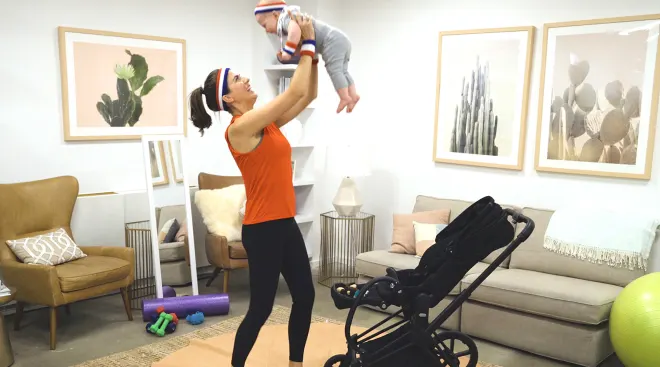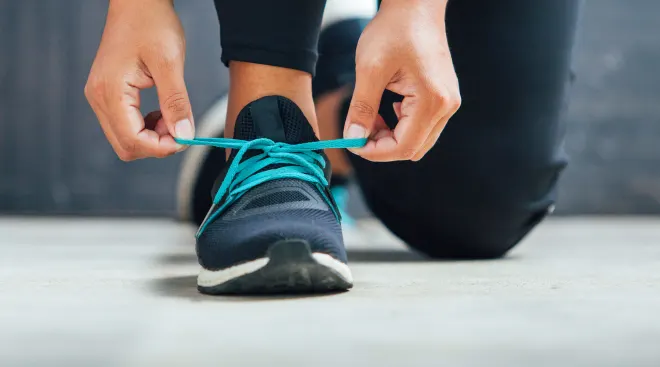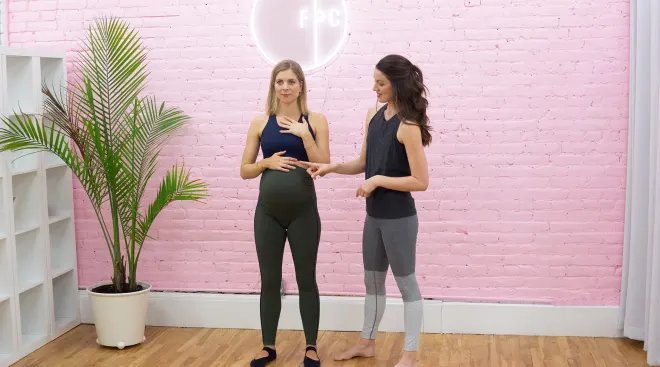8 Best Diastasis Recti Exercises to Heal Your Abs Post-Baby
Your body performs some pretty incredible feats during pregnancy. So it’s not surprising that after pregnancy, you’re likely to experience some major changes. One of these is separation of the abdominal muscles, also known as diastasis recti.
According to Joanie Johnson, CPT, PPCES, DCC, a certified diastasis and core consultant, the rectus abdominis—or “six-pack” muscles—are woven together by a web of connective tissue known as the linea alba. This tissue allows your belly to expand during pregnancy. Ab separation is pretty much expected during pregnancy—but it can stay that way postpartum when the linea alba is super-stretched. Factors that can lead to this are poor posture, improper breathing, the mismanagement of core pressure, improper movement mechanics and plain old genetics, says Johnson.
The good news is that there are plenty of resources for diastasis recti self-care, like exercises you can do at home. It’s good to keep in mind that there’s no such thing as “best” and “worst” diastasis recti exercises for everyone, though. “Every single person with [diastasis recti] is different,” says Ashley Rawlins, PT, DPT, a pelvic and obstetric physical therapist and clinical educator at Origin. “And each individual truly needs an individualized approach to exercise in order to help them feel their strongest and most capable.”
That said, read on for some expert-recommended exercises for diastasis recti—as well as diastasis recti exercises that are best to avoid.
Here are a few exercises for diastasis recti that the experts recommend. Johnson recommends focusing on your recovery for a minimum of five to 10 minutes every day. “Don’t get discouraged! This can be a slow journey, but consistency is important,” she says.
Diaphragmatic breathing
The first step to any diastasis recti workout is learning to breathe properly—which is where diastasis recti breathing exercises come in. “Many of us are ‘chest breathers,’ which often creates neck, shoulder and back pain,” says Johnson. “Chest breathing sets off a chain of muscular imbalances throughout your body, as your breath is neglecting your core’s inherent function.”
To practice diaphragmatic breathing, Johnson says to first lie down on your back. “Our bodies naturally fall into this breath pattern when we’re sleeping, so moving into a position associated with rest can serve as a trigger to move into a deeper diaphragmatic breath pattern,” she says.
- Once you’re on your back, place one hand on your chest and one hand on your belly.
- Inhale a slow, deep breath through your nose and focus on sending the air into your lower ribs and belly. On your inhale, feel your stomach rise.
- Exhale with a “shhh” sound and hug or tighten your abdominals. Here, you’ll feel the belly fall as you empty your body of air.
- Practice this breath in many different positions: on your back, lying on your side, on all fours, kneeling and finally standing upright. Move slowly through the stages and continue practicing until diaphragmatic breathing becomes your new normal.
Pelvic floor activations
“When we inhale, the diaphragm contracts, flattens and draws air into the deepest part of our lungs; at the same time, the pelvic floor gently relaxes,” says Johnson. “When we exhale, the diaphragm relaxes and pushes air out of the lungs while the pelvic floor gently contracts. Diastasis recti exercises should engage both your diaphragm and pelvic floor, as this coordination is essential for core recovery.”
- Lie on your back and tap into your diaphragmatic breath.
- Inhale, fill the lower ribs and belly and think of sending your breath all the way down to the bottom of your pelvis. See if you can feel the muscles of your pelvic floor relax.
- Exhale with your “shhh” sound while thinking of simultaneously stopping yourself from passing gas and stopping the flow of urine. Continue to hug or tighten your abdominals.
This activation is an exercise trademarked by Fit For Birth as the Core Breathing Belly Pump® and is widely used within the pre- and postnatal fitness industry.
Supine marches
It’s important to practice proper core activation as you move your limbs, notes Johnson. “The key to this exercise is making sure your abs don’t push upwards as you lift your leg,” she says. “Focus on a deep core activation that keeps the abs engaged and hugging in towards your midline; never pushing out and away from your body.”
- Lie on your back with your knees bent and feet flat on the floor.
- Inhale, fill your ribs and belly and relax your pelvic floor.
- Exhale and activate your Core Breathing Belly Pump deeply as you march one foot 1 inch off the ground.
- Place your foot back down and inhale, fill your ribs and belly and relax your pelvic floor to prepare.
- Exhale, activate your Core Breathing Belly Pump and repeat the movement on the other side.
Heel slides
“Diastasis recti exercises that focus on releasing tension in the back and hip flexors while activating the pelvic floor and core are excellent for refinding your neutral alignment and coordinating the muscles of your inner core unit,” says Johnson. As you do this exercise, try to initiate the movement from your core.
- Lie on your back with your knees bent and feet flat on the floor.
- Inhale, fill your ribs and belly and relax your pelvic floor.
- Exhale and activate your Core Breathing Belly Pump as you lift your toes and slide your heel away from the body to fully extend the leg.
- Inhale, fill your ribs and belly and relax your pelvic floor to prepare.
- Exhale and activate your Core Breathing Belly Pump as you slide your leg back up to its starting position.
%% VIDEO 6 %%
Leg lifts
Many people lift their legs by using their hip flexors, lower back and by pushing out on their abdominal wall, says Johnson. This diastasis recti exercise promotes the proper use of your core “so your body can begin memorizing what it feels like to use correct core mechanics when increasing the load”—like your leg, she notes.
- Lie on your back with your knees bent and feet flat on the floor.
- Inhale, fill your ribs and belly and relax your pelvic floor.
- Exhale and activate your Core Breathing Belly Pump as you lift your toes and slide your heel away from the body to fully extend the leg.
- Inhale, fill your ribs and belly and relax your pelvic floor to prepare.
- Exhale and activate your Core Breathing Belly Pump as you lift your extended leg 1 inch off the floor and place it back down again.
- Inhale, fill your ribs and belly and relax your pelvic floor to prepare.
- Exhale and activate your Core Breathing Belly Pump as you slide your leg back up to its starting position.
Toe taps
As your core becomes stronger, you can start to make things more challenging. “Lifting the leg to a 90-degree position challenges the core to stay engaged,” says Johnson. “Just holding the leg in that lifted position is work when you have diastasis recti. When that feels strong, you can advance to increasing the load even more with these toe taps.”
- Lie on your back with your knees bent and feet flat on the floor.
- Inhale, fill your ribs and belly and relax your pelvic floor.
- Exhale and activate your Core Breathing Belly Pump deeply as you draw one leg up into a chair position at 90 degrees. This may be your stopping point until your core is ready to progress to the next step. Make sure you can hold the leg here without the abs pushing upwards.
- Inhale to prepare.
- Exhale, deepening your core activation as you tap your toes down to the floor and return to chair position. Aim for five to 10 slow repetitions.
- Repeat on the other leg.
Quadruped paper slides and reaches
“Diagonal exercises train the cross body muscle fibers of the internal and external obliques,” says Johnson. “Movements that properly activate the core while training these cross-body fibers help speed up your diastasis recti recovery by training the muscles of your entire core to work together, not just the ones that have sustained the injury.”
- Set up with strong alignment in an all-fours position. This means placing your shoulders over your wrists (or fists, if you need to protect your wrists) and hips over your knees, and keeping a long line of energy from the top of your head all the way through your spine to the tip of your tailbone.
- Inhale to fill your lower ribs and belly while relaxing the pelvic floor.
- Exhale and activate your Core Breathing Belly Pump as you lift one arm and the opposite leg away, high enough to slide an imaginary piece of paper under those two points, and then return.
- Once all four points are back on the floor, inhale and relax the muscles of the core.
- Repeat on both sides of the body.
- As your core stability becomes stronger, you can advance to sliding your hand and foot away from your body along the floor on your exhale activation.
“Only progress to this exercise when you can properly control the activation of your Core Breathing Belly Pump while lying down,” says Johnson. “If you can’t maintain core support, practice keeping three points on the ground and only lifting one limb at a time instead of two.”
Suitcase carry
Rawlins explains that exercises like suitcase carries help maintain core stability. “[Midline stabilization exercises] can be helpful for building foundational strength when healing [diastasis recti], and work to help you understand how to monitor for pain and symptoms or signs that an exercise is too challenging for your current abilities,” she says. Here’s how to perform one, according to Kerry Kelley, PT, DPT, head of the pelvic health program and clinic manager at Marathon Physical Therapy and Sports Performance in Norwood, Massachusetts:
- Start in a standing position with a kettlebell next to you on the floor.
- Squat down to pick up the kettlebell and hold it in one hand.
- Walk across the room, maintaining an upright position with your torso, and resist the kettlebell bending you out of alignment.
- When you reach the other side of the room, place the kettlebell down, turn around and pick up the kettlebell with the opposite hand.
- Walk back across the room. Repeat.
If you have diastasis recti, there are a few exercises that experts generally advise to avoid. However, keep in mind that everyone’s exercise program will be different.
- High-pressure exercises. “These would be any exercises that increase your intra-abdominal pressure beyond what you’re capable of managing, and worsen [diastasis recti],” says Rawlins. This includes heavy lifting without proper form, or “any exercise that causes you to use bad habits like breath-holding or excessive straining in order to do the exercise.”
- High-impact or fast-paced exercises. “Certain exercises may be too quick or dynamic that it can be difficult to control and assess for proper form as you exercise,” says Rawlins, which could increase the risk of worsening your diastasis recti. This includes certain burpee variations, for example.
- Exercises causing excessive doming or bulging. “Some bulging at your midline may be okay, but excessive intra-abdominal pressure that causes too much strain on your tissues should be avoided,” says Rawlins, adding that a physical therapist can help you better understand what this means. She notes that this could include full sit-ups or leg raises before you’re strong enough to do them safely.
Rawlins adds, however, that not everyone needs to avoid sit-ups, as current research supports a full-body exercise program for diastasis recti that could include sit-ups, crunches and rotational exercises.
“Traditionally, people were told to avoid crunches or sit-ups,” adds Kelley. “However, newer research shows there’s no hard-and-fast rule, and some people may actually benefit from them.”
Again, remember that there’s no single set of diastasis recti exercises that works for everyone. Make sure to check in with a physical therapist so they can help you develop an individualized plan of action to heal your abdominal separation.
Please note: The Bump and the materials and information it contains are not intended to, and do not constitute, medical or other health advice or diagnosis and should not be used as such. You should always consult with a qualified physician or health professional about your specific circumstances.
Plus, more from The Bump:
Joanie Johnson, CPT, PPCES, DCC, is a diastasis and core consultant, pre- and postnatal corrective exercise specialist, certified personal trainer and PregnancySāf coach. She’s the founder of Transformation Nation, a holistic pre- and postnatal service offering pregnancy and postpartum workouts.
Kerry Kelley, PT, DPT, is head of the pelvic health program and clinic manager at Marathon Physical Therapy in Norwood, Massachusetts. She received her Doctor of Physical Therapy degree from Boston University.
Ashley Rawlins, PT, DPT, is a pelvic and obstetric physical therapist and clinical educator at Origin. She specializes in the treatment of pelvic floor muscle dysfunctions.
Journal of Women’s & Pelvic Health Physical Therapy, Use of Exercise in the Management of Postpartum Diastasis Recti: A Systematic Review, January/March 2022
Learn how we ensure the accuracy of our content through our editorial and medical review process.
Navigate forward to interact with the calendar and select a date. Press the question mark key to get the keyboard shortcuts for changing dates.

































